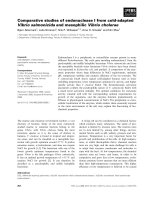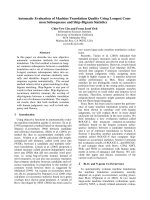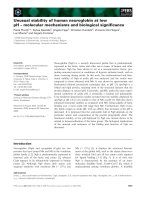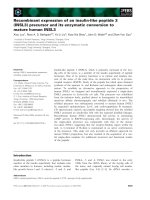Báo cáo toán học: " Hierarchical convergence of an implicit doublenet algorithm for nonexpansive semigroups and variational inequality problems" doc
Bạn đang xem bản rút gọn của tài liệu. Xem và tải ngay bản đầy đủ của tài liệu tại đây (266.1 KB, 10 trang )
RESEARC H Open Access
Hierarchical convergence of an implicit double-
net algorithm for nonexpansive semigroups and
variational inequality problems
Yonghong Yao
1
, Yeol Je Cho
2*
and Yeong-Cheng Liou
3
* Correspondence:
kr
2
Department of Mathematics
Education and the RINS,
Gyeongsang National University,
Chinju 660-701, Republic of Korea
Full list of author information is
available at the end of the article
Abstract
In this paper, we show the hierarchical convergence of the following implicit double-
net algorit hm:
x
s,t
= s[tf (x
s,t
)+(1− t)(x
s,t
− μAx
s,t
)] + (1 − s)
1
λ
s
λ
s
0
T(v)x
s,t
dν, ∀s, t ∈ (0, 1),
where f is a r-contraction on a real Hilbert space H, A : H ® H is an a-inverse
strongly monotone mapping and S ={T(s)}
s ≥ 0
: H ® H is a nonexpansive semi-
group with the common fixed points set Fix(S) ≠ ∅, where Fix(S) denotes the set of
fixed point s of the mapping S, and, for each fixed t Î (0, 1), the net {x
s, t
} converges
in norm as s ® 0 to a common fixed point x
t
Î Fix(S)of{T(s)}
s ≥ 0
and, as t ® 0, the
net {x
t
} converges in norm to the solution x* of the following variational inequality:
x
∗
∈ Fix(S);
Ax
∗
, x − x
∗
≥0, ∀x ∈ Fix( S).
MSC(2000): 49J40; 47J20; 47H09; 65J15.
Keywords: fixed point, variational inequality, double-net algorithm, hierarchical con-
vergence, Hilbert space
1 Introduction
In nonlinear analysis, a common approach to solving a problem with multiple solutions
is to replace it by a family of perturbed problems admitting a unique solution and to
obtain a particular solution as the limit of these perturbed solutions when the pertur-
bation vanishes.
In this paper, we introduce a more general approach which consists in findin g a par-
ticular part of the solution set of a given fixed point problem, i.e., fixed points which
solve a variational inequality. More precisely, the goal of this paper is to present a
method for finding hierarchically a fixed point of a nonexpansive semigroup S ={T(s)}
s
≥ 0
with respect to another monotone operator A, namely,
Find x* Î Fix(S) such that
Ax
∗
, x − x
∗
≥0, ∀x ∈ Fix(S).
(1:1)
Yao et al. Fixed Point Theory and Applications 2011, 2011:101
/>© 2011 Yao et al; licensee Springer. This is an Open Access article distributed under the te rms of the Creative Commons Attribution
License ( which permits unrest ricted use, distribution, and reproduction in any medium,
provided the original work is properly cited.
This is an inte resting topic due to the fact that it is closely related to convex pro-
gramming problems. For the related works, refer to [1-19].
This paper is devoted to solve the problem (1.1). For this purpose, we propose a
double-net algorithm which generates a net {x
s,t
} and prove that the net {x
s,t
} hierarchi-
cally converges to the solution of the problem (1.1), that is, for each fixed t Î (0, 1),
the net {x
s,t
} converges in norm as s ® 0toacommonfixedpointx
t
Î Fix(S)ofthe
nonexpansive semigroup {T(s)}
s ≥ 0
and, as t ® 0, the net {x
t
} converges in norm to
the unique solution x* of the problem (1.1).
2 Preliminaries
Let H be a real Hilbert space with inner product 〈·, ·〉 and norm ||·||, respectively.
Recall a mapping f : H ® H is called a contraction if there exists r Î [0, 1) such that
||f (x) − f (y)|| ≤ ρ||x − y||, ∀x, y ∈ H .
A mapping T : C ® C is said to be nonexpansive if
||Tx − Ty|| ≤ ||x − y||, ∀x, y ∈ H.
Denote the set of fixed points of the mapping T by Fix(T).
Recal l also t hat a family S :={T(s)}
s ≥ 0
of mappings of H into itself is called a non-
expansive semigroup if it satisfies the following conditions:
(S1) T(0)x = x for all x Î H;
(S2) T(s + t)=T(s)T(t) for all s, t ≥ 0;
(S3) ||T(s)x - T(s)y|| ≤ ||x - y|| for all x, y Î H and s ≥ 0;
(S4) for all x Î H, s ® T(s)x is continuous.
We denote by Fix(T(s)) the set of fixed points of T(s)andbyFix(S)thesetofall
common fixed points of S, i.e., Fix(S)=⋂
s ≥ 0
Fix(T(s)). It is known that Fix(S)is
closed and convex ([20], Lemma 1).
A mapping A of H into itself is said to be monotone if
Au − Av, u − v≥0, ∀u, v ∈ H,
and A : C ® H is said to be a-inverse strongly monotone if there exists a positive
real number a such that
Au − Av, u − v≥α||Au − Av||
2
, ∀u, v ∈ H.
It is obvious that any a-inverse strongly monotone mapping A is monotone and
1
α
-Lipschitz continuous.
Now, we introduce some lemmas for our main results in this paper.
Lemma 2.1. [21]Let H be a real Hilbert space. Let the mapping A : H ® Hbea-
inverse strongly monotone and μ >0 be a constant. Then, we have
||(I − μA)x − (I − μA)y||
2
≤||x − y ||
2
+ μ( μ − 2α)||Ax − Ay||
2
, ∀x, y ∈ H.
In particular, if 0 ≤ μ ≤ 2a, then I - μA is nonexpansive.
Lemma 2.2.[22]Let C be a nonempty bounded closed convex subset of a Hilbert
space H and {T(s)}
s ≥ 0
be a nonexpansive semigroup on C. Then, for all h ≥ 0,
Yao et al. Fixed Point Theory and Applications 2011, 2011:101
/>Page 2 of 10
lim
t→∞
sup
x∈C
1
t
t
0
T(s)xds − T( h)
1
t
t
0
T(s)xds
=0.
Lemma 2.3. [23] (Demiclosedness Principle for Nonexpansive Mappings) Let C be a
nonempty closed convex subset of a real Hilbert space H and T : C ® C be a nonex-
pansive mapping with Fix(T) ≠ ∅.If{x
n
} is a sequence in C converging weakly to a
point x Î Cand{(I - T)x
n
} converges strongly to a point y Î C, then (I - T)x = y. In
particular, if y =0, then x Î Fix(T).
Lemma 2.4. LetHbearealHilbertspace.Letf: H ® Hbear-contraction with
coefficient r Î [0, 1) and A : H ® Hbeana-inverse strongly monotone mapping. Let μ
Î (0, 2a) and t Î (0, 1). Then, the variational inequality
x
∗
∈ Fix(S);
tf (z)+(1− t)(I − μA)z − z, x
∗
− z≥0, ∀z ∈ Fix(S),
(2:1)
is equivalent to its dual variational inequality
x
∗
∈ Fix(S);
tf (x
∗
)+(1− t)(I − μA)x
∗
− x
∗
, x
∗
− z≥0, ∀z ∈ Fix(S).
(2:2)
Proof. Assume that x* Î Fix(S) solves the problem (2.1). For all y Î Fix(S), set
x = x
∗
+ s(y − x
∗
) ∈ Fix(S), ∀s ∈ (0, 1).
We note that
tf (x)+(1− t)(I − μA)x − x, x
∗
− x≥0.
Hence, we have
tf (x
∗
+ s(y − x
∗
)) + (1 − t)(I − μA)(x
∗
+ s(y − x
∗
)) − x
∗
− s(y − x
∗
), s(x
∗
− y)≥0,
which implies that
tf (x
∗
+ s(y − x
∗
)) + (1 − t)(I − μA)(x
∗
+ s(y − x
∗
)) − x
∗
− s(y − x
∗
), x
∗
− y≥0.
Letting s ® 0, we have
tf (x
∗
)+(1− t)(I − μA)(x
∗
) − x
∗
, x
∗
− y≥0,
which implies the point x* Î Fix(S) is a solution of the problem (2.2).
Conversely, assume that the point x* Î Fix(S)solvestheproblem(2.2).Then,we
have
tf (x
∗
)+(1− t)(I − μA)x
∗
− x
∗
, x
∗
− z≥0.
Noting that I - f and A are monotone, we have
(I − f)z − (I − f )x
∗
, z − x
∗
≥0
and
Az − Ax
∗
, z − x
∗
≥0.
Yao et al. Fixed Point Theory and Applications 2011, 2011:101
/>Page 3 of 10
Thus, it follows that
t(I − f)z − (I − f)x
∗
, z − x
∗
+(1− t)μAz − Ax
∗
, z − x
∗
≥0,
which implies that
tf (z)+(1− t)(I − μA)z − z, x
∗
− z
≥tf (x
∗
)+(1− t)(I − μA)x
∗
− x
∗
, x
∗
− z
≥ 0.
This implies that the point x* Î Fix(S) solves the problem (2.1). This completes the
proof. □
3 Main results
In this section, we first introduce our double-net algorithm and then p rove a strong
convergence theorem for this algorithm.
Throughout, we assume that
(C1) H is a real Hilbert space;
(C2) f : H ® H is a r-contraction with coefficient r Î [0, 1), A : H ® H is an a-
inverse strongly monotone mapping, and S ={T(s)}
s ≥ 0
: H ® H is a nonexpansive
semigroup with Fix(S) ≠ ∅;
(C3) the solution set Ω of the problem (1.1) is nonempty;
(C4) μ Î (0, 2a) is a constant, and {l
s
}
0 <s<1
is a continuous net of positive real
numbers satisfying lim
s®0
l
s
=+∞.
For any s, t Î (0, 1), we define the following mapping
x → W
s,t
x := s[tf (x)+(1− t)(x − μAx)] + (1 − s)
1
λ
s
λ
s
0
T(ν)xdν.
We note that the mapping W
s, t
is a contraction. In fact, we have
W
s,t
x − W
s,t
y
=
s[tf (x)+(1− t)(x − μAx)] + (1 − s)
1
λ
s
λ
s
0
T(ν)xdν
−s[tf (y)+(1− t)(y − μAy)] − (1 − s)
1
λ
s
λ
s
0
T(ν)ydν
≤ st
f (x) − f(y)|| + s(1 − t)||(x − μAx) − (y − μAy)||
+(1 − s)||
1
λ
s
λ
s
0
(T(ν)x − T(ν)y)dν
≤ stρ||x − y|| + s(1 − t)||x − y|| +(1− s)||x − y||
=[1− (1 − ρ)st ]||x − y||,
which implies that W
s, t
is a contraction. Hence, by Banach’s Contraction Principle,
W
s, t
has a unique fixed point, which is denoted x
s, t
Î H,thatis,x
s, t
is the unique
solution in H of the fixed point equation
x
s,t
= s [tf (x
s,t
)+(1− t)(x
s,t
− μAx
s,t
)]
+(1 − s)
1
λ
s
λ
s
0
T(ν)x
s,t
dν, ∀s, t ∈ (0, 1).
(3:1)
Now, we give some lemmas for our main result.
Lemma 3.1. For each fixed t Î (0, 1), the net {x
s, t
} defined by (3.1) is bounded.
Yao et al. Fixed Point Theory and Applications 2011, 2011:101
/>Page 4 of 10
Proof. Taking any z Î Fix(S), since I - μA is nonexpansive (by Lemma 2.1), it follows
from (3.1) that
x
s,t
− z
=
s[tf (x
s,t
)+(1 − t)(I − μA)x
s,t
]+(1 − s)
1
λ
s
λ
s
0
T(ν)x
s,t
dν − z
≤ s
tf (x
s,t
)+(1 − t)(I − μA)x
s,t
− z
+(1− s)
1
λ
s
λ
s
0
T(ν)x
s,t
dν − z
≤ s
t
f (x
s,t
) − f (z)
+ t
f (z) − z
+(1− t)||(I − μA)x
s,t
− (I − μA)z||
+(1 − t)||(I − μA)z − z||
+(1− s)||x
s,t
− z||
≤ s[tρ||x
s,t
− z|| + t||f(z) − z|| +(1− t)||x
s,t
− z|| +(1− t)μ||Az||]
+(1 − s)||x
s,t
− z||
=[1− (1 − ρ)st]||x
s,t
− z|| + st||f(z) − z|| + s(1 − t)μ||Az||.
This implies that
x
s,t
− z
≤
1
(1 − ρ)t
(t ||f (z) − z|| +(1− t)μ||Az||)
≤
1
(1 − ρ)t
max{||f (z) − z||, μ||Az||}.
Thus, it follows that, for each fixed t Î (0, 1), {x
s, t
} is bounded and so are the nets {f
(x
s, t
)} and {(I - μA )x
s, t
}. This completes the proof. □
Lemma 3.2. x
s, t
® x
t
Î Fix(S) as s ® 0.
Proof. For each fixed t Î (0, 1), we set
R
t
:=
1
(1−ρ)t
max{||f (z) − z||, μ||Az||}
.Itis
clear that, for each fixed t Î (0, 1), {x
s, t
} ⊂ B(p, R
t
), where B(p, R
t
) denotes a closed
ball with the center p and radius R
t
. Notice that
1
λ
s
λ
s
0
T(ν)x
s,t
dν − p
≤||x
s,t
− p|| ≤ R
t
.
Moreover, we observe that if x Î B(p, R
t
), then
||T(s)x − p|| ≤ ||T(s)x − T(s)p|| ≤ ||x − p|| ≤ R
t
,
that is, B(p, R
t
)isT(s)-invariant for all s Î (0, 1). From (3.1), it follows that
T(τ )x
s,t
− x
s,t
≤
T(τ )x
s,t
− T(τ )
1
λ
s
λ
s
0
T(ν)x
s,t
dν
+
T(τ )
1
λ
s
λ
s
0
T(ν)x
s,t
dν −
1
λ
s
λ
s
0
T(ν)x
s,t
dν
+
1
λ
s
λ
s
0
T(ν)X
s,t
dν − x
s,t
≤
T (τ )
1
λ
s
λ
s
0
T(ν)x
s,t
dν −
1
λ
s
λ
s
0
T(ν)x
s,t
dν
+2
x
s,t
−
1
λ
s
λ
s
0
T(ν)X
s,t
dν
≤ 2
S
tf (x
s,t
)+(1 − t)(x
s,t
− μAx
s,t
) −
1
λ
s
λ
s
0
T(ν)x
s,t
dν
+
T(τ )
1
λ
s
λ
s
0
T(ν)x
s,t
dν −
1
λ
s
λ
s
0
T(ν)x
s,t
dν
.
Yao et al. Fixed Point Theory and Applications 2011, 2011:101
/>Page 5 of 10
By Lemma 2.2, for all 0 ≤ τ <∞ and fixed t Î (0, 1), we deduce
lim
s→0
T(τ )x
s,t
− x
s,t
=0.
(3:2)
Next, we show that, for each fixed t Î (0, 1), the net {x
s, t
} is relatively norm-com-
pact as s ® 0. In fact, from Lemma 2.1, it follows that
||x
s,t
− μAx
s,t
− (z − μAz)||
2
≤||x
s,t
− z||
2
+ μ(μ − 2α)||Ax
s,t
− Az||
2
.
(3:3)
By (3.1), we have
||x
s,t
− z||
2
= stf(x
s,t
) − f (z), x
s,t
− z + stf (z) − z, x
s,t
− z
+s(1 − t)(I − μA)x
s,t
− (I − μA)z, x
s,t
− z
+s(1 − t)(I − μA)z − z, x
s,t
− z
+(1 − s)
1
λ
s
λ
s
0
T(ν)X
s,t
dν − z, x
s,t
− z
≤ st||f (x
s,t
) − f (z)|| ||x
s,t
− z|| + stf (z) − z, x
s,t
− z
+s(1 − t)||(I − μA) x
s,t
− (I − μA)z|| ||x
s,t
− z|| − s(1 − t)μAz, x
s,t
− z
+(1 − s)
1
λ
s
λ
s
0
T(ν)X
s,t
dν − z|| ||x
s,t
− z
≤ stρ||x
s,t
− z||
2
+ stf (z) − z, x
s,t
− z−s(1 − t)μAz, x
s,t
− z
+s(1 − t)||(I − μA) x
s,t
− (I − μA)z|| ||x
s,t
− z|| +(1− s)||x
s,t
− z||
2
≤ stρ||x
s,t
− z||
2
+ stf (z) − z, x
s,t
− z−s(1 − t)μAz, x
s,t
− z
+
s(1 − t)
2
(||(I − μA)x
s,t
− (I − μA)z||
2
+ ||x
s,t
− z||
2
)+(1− s)||x
s,t
− z||
2
.
This together with (3.3) imply that
||x
s,t
− z||
2
≤ stρ||x
s,t
− z||
2
+ stf (z) − z, x
s,t
− z−s(1 − t)μAz, x
s,t
− z
+
s(1 − t)
2
(||x
s,t
− z||
2
+ μ(μ − 2α)||Ax
s,t
− Az||
2
+ ||x
s,t
− z||
2
)+(1− s)||x
s,t
− z||
2
≤ [1 − (1 − ρ)st]||x
s,t
− z||
2
+ stf (z) − z, x
s,t
− z
−s(1 − t)μAz, x
s,t
− z,
which implies that
||x
s,t
− z||
2
≤
1
(1 − ρ)t
tf (z)+(1− t)(I − μA)z − z, x
s,t
− z, ∀z ∈ Fix(S).
(3:4)
Assume that {s
n
} ⊂ (0, 1) is such that s
n
® 0asn ® ∞. By (3.4), we obtain immedi-
ately that
||x
s
n
,t
− z||
2
≤
1
(1 − ρ)t
tf (z)+(1− t)(I − μA)z − z, x
s
n
,t
− z, ∀z ∈ Fix(S).
(3:5)
Since
{x
s
n
,t
}
is bounded, without loss of generality, we may assume that, as s
n
® 0,
{x
s
n
,t
}
converges weakly to a point x
t
. From (3.2) and Lemma 2.3, we get x
t
Î Fix(S).
Yao et al. Fixed Point Theory and Applications 2011, 2011:101
/>Page 6 of 10
Further, if we substitute x
t
for z in (3.5), then it follows that
||x
s
n
,t
− x
t
||
2
≤
1
(1 − ρ)t
tf (x
t
)+(1− t)(I − μA)x
t
− x
t
, x
s
n
,t
− x
t
.
Therefore, the weak convergence of
{x
s
n
,t
}
to x
t
actually implies that
x
s
n
,t
→ x
t
strongly. This has proved the relative norm-compactness of the net {x
s, t
}ass ® 0.
Now, if we take the limit as n ® ∞ in (3.5), we have
x
t
− z
2
≤
1
(1 − ρ)t
tf (z)+(1− t)(I − μA)z − z, x
t
− z, ∀z ∈ Fix(S).
In particular, x
t
solves the following variational inequality:
x
t
∈ Fix(S);
tf (z)+(1− t)(I − μA)z − z, x
t
− z≥0, ∀z ∈ Fix(S),
or the equivalent dual variational inequality (see Lemma 2.4):
x
t
∈ Fix(S);
tf (x
t
)+(1− t)(I − μA)x
t
− x
t
, x
t
− z≥0, ∀z ∈ Fix(S).
(3:6)
Notice that (3.6) is equivalent to the fact that x
t
= P
Fix(S)
(tf +(1-t)(I - μA))x
t
, that is,
x
t
is the unique element in Fix(S) of the contract ion P
Fix(S)
(tf +(1-t)(I -μA)). Clearly, it
is sufficient to conclude that the entire net {x
s, t
} converges in norm to x
t
Î Fix(S )ass
® 0. This completes the proof. □
Lemma 3.3. The net { x
t
} is bounded.
Proof. In (3.6), if we take any y Î Ω, then we have
tf (x
t
)+(1− t)(I − μA)x
t
− x
t
, x
t
− y≥0.
(3:7)
By virtue of the monotonicity of A and the fact that y Î Ω, we have
(I − μA)x
t
− x
t
, x
t
− y≤(I − μA)y − y, x
t
− y≤0.
(3:8)
Thus, it follows from (3.7) and (3.8) that
f (x
t
) − x
t
, x
t
− y≥0, ∀y ∈
(3:9)
and hence
x
t
− y
2
≤x
t
− y, x
t
− y + f (x
t
) − x
t
, x
t
− y
= f (x
t
) − f(y), x
t
− y + f (y) − y, x
t
− y
≤ ρ x
t
− y
2
+ f(y) − y, x
t
− y.
Therefore, we have
||x
t
− y||
2
≤
1
1 − ρ
f (y) − y, x
t
− y, ∀y ∈ .
(3:10)
In particular,
||x
t
− y|| ≤
1
1 − ρ
|| f (y) − y||, ∀t ∈ (0, 1),
Yao et al. Fixed Point Theory and Applications 2011, 2011:101
/>Page 7 of 10
which implies that {x
t
} is bounded. This completes the proof. □
Lemma 3.4. If the net {x
t
} converges in norm to a point x* Î Ω, then the point solves
the variational inequality
(I − f )x
∗
, x − x
∗
≥0, ∀x ∈ .
(3:11)
Proof. First, we note that the solution of the variational inequality (3.11) is unique.
Next, w e prove that ω
w
(x
t
) ⊂ Ω,thatis,if(t
n
) is a null sequence in (0, 1) such that
x
t
n
→ x
weakly as n ® ∞ , then x’ Î Ω. To see this, we use (3.6) to get
μAx
t
, z − x
t
≥
t
1 − t
(I − f )x
t
, x
t
− z, ∀z ∈ Fix(S).
However, since A is monotone, we have
Az, z − x
t
≥Ax
t
, z − x
t
.
Combining the last two relations yields that
μAz, z − x
t
≥
t
1 − t
(I − f )x
t
, x
t
− z, ∀z ∈ Fix(S).
(3:12)
Letting t = t
n
® 0asn ® ∞ in (3.12), we get
Az, z − x
≥0, ∀z ∈ Fix(S),
which is equivalent to its dual variational inequality
Ax
, z − x
≥0, ∀z ∈ Fix(S).
That is, x’ is a solution of the problem (1.1) and hence x’ Î Ω.
Finally, we prove that x’ = x*, the unique solution of the variational inequality (3.11).
In fact, by (3.10), we have
||x
t
n
− x
||
2
≤
1
1 − ρ
f (x
) − x
, x
t
n
− x
, ∀x
∈ .
Therefore, the weak convergence to x’ of
{x
t
n
}
implies that
x
t
n
→ x
in norm. Thus, if
we let t = t
n
® 0 in (3.10), then we have
f (x
) − x
, y − x
≤0, ∀y ∈ ,
which implies that x’ Î Ω solves the problem (3. 11). By the uniqueness of the solu-
tion, we have x’ = x* and it is sufficient to guarantee that x
t
® x*innormast ® 0.
This completes the proof. □
Thus, by the above lemmas, we can obtain immediately the following theorem.
Theorem 3.5. For each (s, t) Î (0, 1) × (0, 1),let{x
s, t
} be a double-net algorithm
defined implicitly by (3.1). Then, the net {x
s, t
} hierarchically converges to the unique
solution x * of the h ierarchica l fixed point problem and t he variational inequality pro-
blem (1.1), that is, for each fixed t Î (0, 1), the net {x
s, t
} converges in norm as s ® 0 to
a common fixed point x
t
Î Fix(S) of the nonexpansive semigroup {T(s)}
s ≥ 0
. Moreover,
as t ® 0, the net {x
t
} converges in norm to the unique solution x* Î Ω and the point x*
Yao et al. Fixed Point Theory and Applications 2011, 2011:101
/>Page 8 of 10
also solves the following variational inequality.
x
∗
∈ ;
(I − f )x
∗
, x − x
∗
≥0, ∀x ∈ .
Acknowledgements
Yonghong Yao was supported in part by Colleges and Universities Science and Technology Development Foundation
(20091003) of Tianjin and NSFC 11071279. Yeol Je Cho was supported by the Korea Research Foundation Grant
funded by the Korean Government (KRF-2008-313-C00050). Yeong-Cheng Liou was supported in part by NSC 99-2221-
E-230-006.
Author details
1
Department of Mathematics, Tianjin Polytechnic University, Tianjin 300160, People’s Republic of China
2
Department of
Mathematics Education and the RINS, Gyeongsang National University, Chinju 660-701, Republic of Korea
3
Department
of Information Management, Cheng Shiu University, Kaohsiung 833, Taiwan
Authors’ contributions
All authors read and approved the final manuscript.
Competing interests
The authors declare that they have no competing interests.
Received: 3 November 2010 Accepted: 20 December 2011 Published: 20 December 2011
References
1. Moudafi, A, Mainge, PE: Towards viscosity approximations of hierarchical fixed-point problems. Fixed Point Theory Appl
1–10 (2006). Article ID 95453
2. Moudafi, A: Krasnoselski-Mann iteration for hierarchical fixed-point problems. Inverse Problems. 23, 1635–1640 (2007).
doi:10.1088/0266-5611/23/4/015
3. Mainge, PE, Moudafi, A: Strong convergence of an iterative method for hierarchical fixed-point problems. Pacific J
Optim. 3, 529–538 (2007)
4. Yao, Y, Liou, YC: Weak and strong convergence of Krasnoselski-Mann iteration for hierarchical fixed point problems.
Inverse Problems 24(1):8 (2008). 015015
5. Cianciaruso, F, Marino, G, Muglia, L, Yao, Y: On a two-step algorithm for hierarchical fixed Point problems and
variational inequalities. J Inequal Appl 13 (2009). Article ID 208692 doi:10.1155/2009/208692
6. Cianciaruso, F, Colao, V, Muglia, L, Xu, HK: On an implicit hierarchical fixed point approach to variational inequalities.
Bull Aust Math Soc. 80, 117–124 (2009). doi:10.1017/S0004972709000082
7. Marino, G, Colao, V, Muglia, L, Yao, Y: Krasnoselski-Mann iteration for hierarchical fixed points and equilibrium problem.
Bull Aust Math Soc. 79, 187–200 (2009). doi:10.1017/S000497270800107X
8. Lu, X, Xu, HK, Yin, X: Hybrid methods for a class of monotone variational inequalities. Nonlinear Anal. 71, 1032–1041
(2009). doi:10.1016/j.na.2008.11.067
9. Yao, Y, Chen, R, Xu, HK: Schemes for finding minimum-norm solutions of variational inequalities. Nonlinear Anal. 72,
3447–3456 (2010). doi:10.1016/j.na.2009.12.029
10. Yao, Y, Liou, YC, Marino, G: Two-step iterative algorithms for hierarchical fixed point problems and variational inequality
problems. J Appl Math Comput. 31, 433–445 (2009). doi:10.1007/s12190-008-0222-5
11. Yao, Y, Cho, YJ, Liou, YC: Iterative algorithms for hierarchical fixed points problems and variational inequalities. Math
Comput Model. 52, 1697–1705 (2010). doi:10.1016/j.mcm.2010.06.038
12. Xu, HK: Viscosity method for hierarchical fixed point approach to variational inequalities. Taiwan J Math. 14, 463–478
(2010)
13. Colao, V, Marino, G, Muglia, L: Viscosity methods for common solutions for equilibrium and hierarchical fixed point
problems. Optim (in press). doi:10.1080/02331930903524688
14. Ceng, LC, Petrusel, A: Krasnoselski-Mann iterations for hierarchical fixed point problems for a finite family of nonself
mappings in Banach spaces. J Optim Theory Appl. doi:10.1007/s10957-010-9679-0
15. Cabot, A: Proximal point algorithm controlled by a slowly vanishing term: applications to hierarchical minimization.
SIAM J Optim. 15, 555–572 (2005). doi:10.1137/S105262340343467X
16. Luo, ZQ, Pang, JS, Ralph, D: Mathematical Programs with Equilibrium Constraints. Cambridge University Press,
Cambridge (1996)
17. Solodov, M: An explicit descent method for bilevel convex optimization. J Convex Anal. 14, 227–237 (2007)
18. Yamada, I, Ogura, N: Hybrid steepest descent method for the variational inequality problem over the fixed point set of
certain quasi-nonexpansive mappings. Numer Funct Anal Optim. 25, 619–655 (2004)
19. Guo, G, Wang, S, Cho, YJ: Strong convergence algorithms for hierarchical fixed point problems and variational
inequalities. J Appl Math Vol 17 (2011). Article ID 164978, doi:10.1155/2011/164978
20. Browder, FE: Convergence of approximation to fixed points of nonexpansive non-linear mappings in Hilbert spaces.
Arch Rational Mech Anal. 24,82–90 (1967)
21. Takahashi, W, Toyoda, M: Weak convergence theorems for nonexpansive mappings and monotone mappings. J Optim
Theory Appl. 118, 417–428 (2003). doi:10.1023/A:1025407607560
22. Shimizu, T, Takahashi, W: Strong convergence to common fixed points of families of nonexpansive mappings. J Math
Anal
Appl. 211,71–83 (1997). doi:10.1006/jmaa.1997.5398
Yao et al. Fixed Point Theory and Applications 2011, 2011:101
/>Page 9 of 10
23. Geobel, K, Kirk, WA: Topics in Metric Fixed Point Theory. In Cambridge Studies in Advanced Mathematics, vol. 28,
Cambridge University Press (1990)
doi:10.1186/1687-1812-2011-101
Cite this article as: Yao et al.: Hierarchical convergence of an implicit double-net algorithm for nonexpansive
semigroups and variational inequality problems. Fixed Point Theory and Applications 2011 2011:101.
Submit your manuscript to a
journal and benefi t from:
7 Convenient online submission
7 Rigorous peer review
7 Immediate publication on acceptance
7 Open access: articles freely available online
7 High visibility within the fi eld
7 Retaining the copyright to your article
Submit your next manuscript at 7 springeropen.com
Yao et al. Fixed Point Theory and Applications 2011, 2011:101
/>Page 10 of 10









